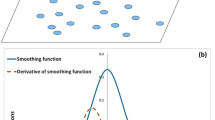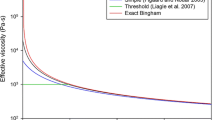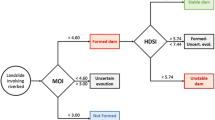Abstract
Debris flow modelling has become an important tool for assessing the related hazard so as to undertake appropriate mitigation actions and reduce the associated risk. Volume values are key input data for landslides numerical modelling. This work analyses the influence of the uncertainties related to initial volume and initial mass morphology (using the aspect ratio as a parameter) on the spreading of Bingham fluid. The dependency of this effect on slope changes is also analysed using three interesting landscape configurations: a horizontal plane, a simplified bilinear topography with increasing slope angle, and a real topography (Colima volcano landscape). We use the smoothed particle hydrodynamics (SPH) model to carry out this analysis. The SPH model is a depth-integrated model, which was previously validated by reproducing problems with analytical results (1D break dam). The initial aspect ratio is a primordial control parameter of the spreading in the case of a quasi-horizontal plane or very gentle slope, but this effect dissipates when the slope angle increases and the flow dynamics become essentially controlled by its volume. Even if most hydrodynamic models using different rheological approach can successfully reproduce real events, input data uncertainties and model sensitivity should be taken into account.











Similar content being viewed by others
References
Barré de Saint-Venant A (1871) Théorie du mouvement non permanent des eaux. Comptes-Rendus de l’Académie des Sciences 73:147–237
Bonet J, Kulasegaram S (2000) Correction and stabilization of smooth particle hydrodynamics methods with applications in metal forming simulations. Int J Numer Methods Eng 47:1189–1214
Bonet J, Rodríguez-Paz MX (2005) A corrected smooth particle hydrodynamics formulation of the shallow-water equations. Comput Struct 83:1396–1410
Brufau P, García-Navarro P, Ghilardi P, Natale L, Savi F (2000) 1D mathematical modelling of debris flow. J Hydraul Res 38:435–446
Capra L, Norini G, Groppelli G, Macías JL, Arce JL (2008) Volcanic hazard zonation of the Nevado de Toluca volcano, México. J Volcanol Geoth Res 176:469–484
Carrasco-Núñez G, Siebert L, Capra L (2011) Hazards from volcanic avalanches. In: Horizons in earth science research. Nova Science Publishers, New York
Chang Ch-W, Lin P-S, Tsai Ch-L (2011) Estimation of sediment volume of debris flow caused by extreme rainfall in Taiwan. Eng Geol 123:83–90
Charbonnier SJ, Gertisser R (2012) Evaluation of geophysical mass flow models using the 2006 block-and-ash flows of Merapi Volcano, Java, Indonesia: towards a short-term hazard assessment tool. J Volcanol Geoth Res 231–232:87–108
Cola S, Calabrò N, Pastor M (2008) Prediction of the flow-like movements of Tessina landslide by SPH model. In: Chen et al (eds) Landslides and engineered slopes. Taylor & Francis Group, London
Cortés A, Macías JL, Capra L, Garduño-Monroy VH (2010) Sector collapse of the SW flank of Volcán de Colima, México The 3600 yr BP La Lumbre-Los Ganchos debris avalanche and associated debris flows. J Volcanol Geoth Res 197(1–4):52–66
Coussot P, Piau JM (1994) Some considerations on debris flow rheology. In: Ergenzinger P, Schmidt KH (eds), Dynamics and geomorphology of mountain rivers, Lectures Notes in Earth Sciences, vol 52, pp 315–326
Davies TRH (1982) Spreading of rock avalanche debris by mechanical fluidization. Rock Mech 15:9–24
Dávila N, Capra L, Gavilanes-Ruiz JC, Varley N, Norini G, Gómez-Vázquez A (2007) Recent lahars at Volcán de Colima (Mexico): drainage variation and spectral classification. J Volcanol Geoth Res 165:127–141
Denlinger RP, Iverson RM (2001) Flow of variably fluidized granular masses across three-dimensional terrain 2. Numerical predictions and experimental tests. J Geophys Res 116:E10001
Fraccarollo L, Papa M (2000) Numerical simulation of real debris-flow events. Phys Chem Earth Part B 25(9):757–763
Friedel MJ (2011) A data-driven approach for modeling post-fire debris-flow volumes and their uncertainty. Environ Model Softw 26:1583–1598
Gartner JE, Cannon SH, Santi PM, Dewolfe VG (2008) Empirical models to predict the volumes of debris flows generated by recently burned basins in the western US. Geomorphology 96:339–354
Gingold RA, Monaghan JJ (1977) Smoothed particle hydrodynamics: theory and application to non-spherical stars. Monthly Notices of the Royal Astronomical Society, pp 375–389
Gingold RA, Monaghan JJ (1982) Kernel estimates as a basis for general particle methods in hydrodynamics. J Comput Phys 46:429
Haddad B, Pastor M, Palacios D, Muñoz-Salinas E (2010) A SPH depth integrated model for Popocatépetl 2001 lahar (Mexico): sensitivity analysis and runout simulation. Eng Geol 114:312–329
Hsü KJ (1975) Catastrophic debris streams (Sturzstroms) generated by rockfalls. Geol Soc Am Bull 86:129–140
Hubbard BE, Sheridan MF, Carrasco-Núñez G, Díaz-Castellón R, Rodríguez SR (2007) Comparative lahar hazard mapping at Volcan Citlaltépetl, Mexico using SRTM, ASTER and DTED-1 digital topographic data. J Volcanol Geoth Res 160:99–124
Hungr O (1995) A model for the runout analysis of rapid flow slides, debris flows and avalanches. Can Geotech J 32:610–623
Hungr D, Evans SG (2004) Entrainment of debris in rock avalanches: an analysis of a long run-out mechanism. Geol Soc Am Bull 116(9–10):1240–1252
Hungr O, Corominas J, Eberhardt E (2005) Estimating landslide motion mechanism, travel distance and velocity. In: Hungr O et al (eds) Landslide risk management. Taylor and Francis, London
Huppert HE, Dade WB (1998) Natural disasters: explosive volcanic eruptions and gigantic landslides. Theoret Comput Fluid Dyn 10:201–212
Hutchinson JN (1986) A sliding-consolidation model for flow slides. Can Geotech J 23:115–126
Hutter K, Svendsen B, Rickenmann D (1996) Debris flow modeling: a review. Contin Mech Thermodyn 8:1–35
Igwe O, Sassa K, Fukuoka H (2006) Excess pore water pressure: a major factor for catastrophic landslides. 10th IAEG international congress, Nottingham, United Kingdom
Imran J, Parker G, Locat J, Lee H (2001) 1D Numerical model of muddy subaqueous and subaerial debris flows. J Hydraul Eng 127(11):959–967
Iverson RM (1997) The physics of debris flows. Rev Geophys 35:245–296
Iverson RM (2000) Landslide triggering by rain infiltration. Water Resour Res 36:1897–1910
Janda RJ, Meyer DF, Childers D (1985) Sedimentation and geomorphic changes during and following the 1980–1983 eruptions of Mount St. Helens, Washington. Shin-Sabo J Eros Control Eng Soc Jpn 37:5–19
Laigle D, Coussot P (1997) Numerical Modeling of Mudflows. J Hydraul Eng 123:617–623
Lajeunesse E, Mangeney-Castelnau A, Vilotte JP (2004) Spreading of a granular mass on a horizontal plane. Am Inst Phys 16(7):2371–2381
Legros F (2002) The mobility of long-runout landslide. Eng Geol 63:301–331
Liu K-F, Huang M (2006) Numerical simulation of debris flow with application on hazard area mapping. Comput Geosci 10(2):221–240
Lube G, Huppert HE, Sparks RSJ, Hallworth MA (2004) Axisymmetric collapses of granular columns. J Fluid Mech 508:175–199
Lucy LB (1977) Numerical approach to testing of fission hypothesis. Astron J 82:1013–1024
Macías JL, Capra L, Arce JL, Espíndola JM, García-Palomo A, Sheridan MF (2008) Hazard map of El Chichón volcano, Chiapas, México: constraints posed by eruptive history and computer simulations. J Volcanol Geoth Res 175:444–458
Malet JP, Maquaire O, Locat J, Remaitre A (2004) Assessing debris flow hazards associated with slow moving landslides: methodology and numerical analyses. Landslides 1:83–90
Mangeney-Castelnau A, Bouchut F, Vilotte JP, Lajeunesse E, Aubertin A, Pirulli M (2005) On the use of Saint Venant equations to simulate the spreading of a granular mass. J Geophys Res 110:B09103
Marchi L, Cavalli M, D’Agostino V (2010) Hydrogeomorphic processes and torrent control works on a large alluvial fan in the eastern Italian Alps. Nat Hazards Earth Syst Sci 10:547–558
McDougall S, Hungr O (2004) A model for the analysis of rapid landslide motion across three-dimensional terrain. Can Geotech J 41(12):1084–1097
Monaghan JJ, Gingold RA (1983) Shock simulation by the particle method SPH. J Comput Phys 52:374–389
Monaghan JJ, Cas RF, Kos A, Hallworth M (1999) Gravity currents descending a ramp in a stratified tank. J Fluid Mech 379:36–39
Muñoz-Salinas E, Renschler C, Palacios D, Namikawa LM (2008) Updating channel morphology in digital elevation models: lahar assessment for Tenenepanco-Huiloac Gorge, Popocatépetl volcano, Mexico. Nat Hazards 45:309–320
Naef D, Rickenmann D, Rutschmann P, McArdell BW (2006) Comparison of flow resistance relations for debris flows using a one-dimensional finite element simulation model. Nat Hazards Earth Syst Sci 6:155–165
O’Brien JS, Julien PY (1988) Laboratory analysis of mudflow properties. J Hydraul Eng 110:877–887
Okada Y, Sassa K, Fukuoka H (2004) Excess pore pressure and grain crushing of sands by means of undrained and naturally drained ring-shear tests. Eng Geol 75:325–343
Pailha M, Nicolas M, Pouliquen O (2008) Initiation of underwater granular avalanches: influences of the initial volume fraction. Phys Fluids 20:11701
Pastor M, Quecedo M, Fernández Merodo JA, Herreros MI, González E, Mira P (2002) Modelling Tailing Dams and mine waste dumps failures. Geotechnique 52(8):579–592
Pastor M, Quecedo M, González E, Herreros I, Fernández Merodo JA, Mira P (2004) A simple approximation to bottom friction for Bingham fluid depth integrated models. J Hydraul Eng ASCE 130(2):149–155
Pastor M, Herreros I, Fernández Merodo JA, Mira P, Haddad B, Quecedo M, González E, Alvarez-Cedrón C, Drempetic V (2009a) Modelling of fast catastrophic landslides and impulse waves induced by them in fjords, lakes and reservoirs. Eng Geol 109:124–134
Pastor M, Blanc T, Pastor MJ (2009b) A depth-integrated viscoplastic model for dilatant saturated cohesive-frictional fluidized mixtures: application to fast catastrophic landslides. J Nonnewton Fluid Mech 158:142–153
Pastor M, Blanc T, Haddad B, Petrone S, Sanchez Morles M, Drempetic V, Issler D, Crosta GB, Cascini L, Sorbino G, Cuomo S (2014) Application of SPH depth-integrated model to landslide run-out analysis. Landslides. doi:10.1007/s10346-014-0484
Patra A, Bauer A, Nichita C, Pitman E, Sheridan MF, Bursik M, Rupp B, Webber A, Namikawa L, Renschler C (2005) Parallel adaptive numerical simulation of dry avalanches over natural terrain. J Volcanol Geoth Res 139:1–21
Phillips JC, Hogg AJ, Kerswell RR, Thomas NH (2006) Enhanced mobility of granular mixtures of fine and coarse particles. Earth Planet Sci Lett 246:466–480
Pierson TC (1995) Flow characteristics of large eruption-triggered debris flows at snow-clad volcanoes: constraints for debris-flow models. J Volcanol Geoth Res 66:283–294
Pitman EB, Le L (2005) A two-fluid model for avalanche and debris flows. Philos Trans R Soc 363:1573–1601
Pouliquen O, Forterre Y (2002) Friction law for dense granular flows: application to the motion of a mass down a rough inclined plane. J Fluid Mech 453:133–151
Pudasaini SP, Hutter K, Hsiau S–S, Tai S-Ch, Wang Y, Ratzenbach R (2007) Rapid flow of dry granular materials down inclined chutes impinging on rigid walls. Phys Fluids 19:053302
Quecedo M, Pastor M (2003) Finite element modelling of free surface flows on inclined and curved beds. J Comput Phys 189(1):45–62
Rickenmann D, Laigle D, McArdell BW, Hübl J (2006) Comparison of 2D debris-flow simulation models with field events. Comput Geosci 10(1):241–264
Robinson JE, Clynne MA (2012) Lahar Hazard Zones for Eruption-Generated Lahars in the Lassen Volcanic Center, California. U.S. Department of the Interior & U.S. Geological Survey, Scientific Investigations Report 2012-5176-C
Rocco R, Bétemps N, Navillod E, Buonaiuto E, Rezzarp G, Ropele P (2012) Standard methodology to study debris flow hazard and risk mitigation in alpine basins. 12th Congress INTERPRAEVENT 2012Grenoble/France, pp 326–327
Roussel N, Coussot P (2005) Fifty-cent rheometer for yield stress measurements: from slump to spreading flow. J Rheol 49:705
Sánchez ME, Pastor M, Romana MG (2013) Modelling of short runout propagation landslides and debris flows. In Georisk: assessment and management of risk for engineered systems and geohazards. Taylor and Francis Group, New York
Santi P, Morandi L (2013) Comparison of debris-flow volumes from burned and unburned areas. Landslides 10:757–769
Savage SB, Hutter K (1989) The motion of a finite mass of granular material down a rough incline. J Fluid Mech 199:177–215
Schneider D, Delgado-Granados H, Huggel C, Kääb A (2008) Assessing lahars from ice-capped volcanoes using ASTER satellite data, the SRTM DTM and two different flow models: case study on Iztaccíhuatl (Central Mexico). Nat Hazards Earth Syst Sci 8:559–571
Sheridan MF, Stinton AJ, Patra A, Pitman EB, Bauer A, Nichita CC (2005) Evaluating Titan2D mass-flow model using the 1963 Little Tahoma Peak avalanches, Mount Rainier, Washington. J Volcanol Geoth Res 139:89–102
Siavoshi S, Kudrolli A (2005) Failure of a granular step. Phys Rev E Am Phys Soc 71:051302
Smith GA, Fritz WJ (1989) Volcanic influences on terrestrial sedimentation. Geology 17:375–376
Tsai MP, Hsü YC, Li HC, Shu HM, Liu KF (2011) Application of simulation technique on debris flow hazard zone delineation: a case study in the Daniao tribe, Eastern Taiwan. Nat Hazards Earth Syst Sci 11:3053–3062
Wang Y, Hutter K (1999) A constitutive theory of fluid-saturated granular materials and its application in gravitational flows. Rheol Acta 38:214–223
Williams R, Stinton AJ, Sheridan MF (2008) Evaluation of the Titan2D two-phase flow model using an actual event: case study of the 2005 Vazcún Valley Lahar. J Volcanol Geoth Res 177:760–766
Yoshida H, Sugai T (2007) Magnitude of the sediment transport event due to the Late Pleistocene sector collapse of Asama volcano, central Japan. Geomorphology 86:61–72
Zienkiewcz OC, Chang C, Bettes P (1980) Drained undrained consolidating and dynamic behavior assumptions in soils. Geotechnique 30(4):385–395
Zienkiewicz OC, Shiomi T (1984) Dynamic behaviour of saturated porous media: the generalised Biot formulation and its numerical solution. Int J Numer Anal Method Geomech 8:71–96
Zienkiewicz OC, Chan AHC, Pastor M, Paul DK, Shiomi T (1990a) Static and dynamic behaviour of soils: a rational approach to quantitative solutions. I. Fully saturated problems. Proc R Soc Lond A 429:285–309
Zienkiewicz OC, Xie YM, Schrefler BA, Ledesma A, Bicanic N (1990b) Static and dynamic behaviour of soils: a rational approach to quantitative solutions. II. Semi-saturated problems. Proc R Soc Lond A 429:311–321
Zienkiewicz OC, Chan AHC, Pastor M, Shrefler BA, Shiomi T (2000) Computational geomechanics, Wiley, New Jersey
Acknowledgments
This work has been supported by CGL 2012-35858 project (CRYOCRISIS), Geografía Física de Alta Montaña research group (GFAM), BIA2009-14225-C02-01 project (GEODYN) and GEOFLOW project from the Ministerio de Economía y Competitividad of Spain.
Author information
Authors and Affiliations
Corresponding author
Rights and permissions
About this article
Cite this article
Calvo, L., Haddad, B., Pastor, M. et al. Runout and deposit morphology of Bingham fluid as a function of initial volume: implication for debris flow modelling. Nat Hazards 75, 489–513 (2015). https://doi.org/10.1007/s11069-014-1334-x
Received:
Accepted:
Published:
Issue Date:
DOI: https://doi.org/10.1007/s11069-014-1334-x




